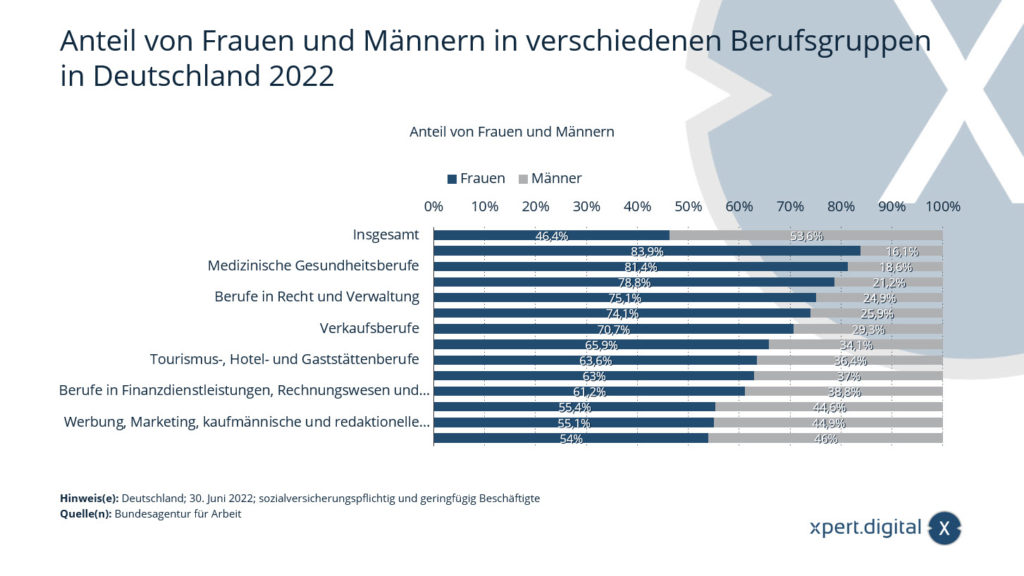Sales & Marketing: B2B communication with decision-makers in leadership positions – when it comes to extended reality and metaverse
Language selection 📢
Published on: September 19, 2023 / update from: September 19, 2023 - Author: Konrad Wolfenstein

Sales & Marketing: B2B communication with decision-makers in management positions – Image: Xpert.Digital
🗒️ How to communicate with decision-makers in leadership positions?
Especially in the B2B sector, where around 24% of managers are women and 76% men? What do I have to pay attention to and where should I focus when I benefit this target group from digital transformation such as: B. wants to convince Metaverse and XR technologies?
Communication with managers, especially in the B2B sector, requires sensitivity, strategy and the right approach. This is especially important when it comes to convincing them about digital transformation, the Metaverse and XR technologies. Here are some recommendations:
1. Understand your target audience 🎯
It is essential to know the needs, wants and problems of your target group. This is the only way you can offer tailor-made solutions that are truly convincing.
2. Use clear and simple language 📝
Avoid technical jargon unless absolutely necessary. Your goal should be to explain concepts in a simple and understandable way so that decision makers can see the benefits and benefits of the technology.
3. Build trust 🤝
Managers want to know that they can rely on you. Show examples of successful implementations and present case studies to demonstrate your credibility.
4. Gender awareness 🚻
Consider the gender balance in leadership positions. Gender stereotypes should be avoided. Women in leadership positions often have different perspectives and experiences than their male colleagues. Be empathetic and respectful in your communication.
5. Use storytelling 📖
People love stories. Tell stories about companies that have successfully entered the Metaverse or XR technologies. This helps make the benefits tangible and shows what is possible.
6. Show ROI 💰
For many decision makers, return on investment (ROI) is crucial. Show clear cost savings, revenue increases, or other measurable benefits of digital transformation.
7. Offer training 🎓
One of the biggest barriers to adopting new technologies is often the fear of the unknown. Through training, you can reduce these fears and provide managers with the necessary knowledge.
8. Show future prospects 🚀
Show what these technologies might look like in the future and how they can help the company stay competitive.
9. Get feedback and respond 🔊
Give decision makers the opportunity to ask questions and raise concerns. Listen to them and respond accordingly.
10. Be authentic ❤️
People can detect insincerity. Be honest about the pros and cons of the technology and why you believe it will be beneficial to the company.
Guide to communicating with managers 🌐
- Know your audience 🎯: Understand who your audience is and what they need.
- Simple language 📝: Clear communication is key.
- Build trust 🤝: Show that you are reliable and competent.
- Gender perspectives 🚻: Be aware of gender dynamics and communicate accordingly.
- Use storytelling 📖: Stories can be more convincing than facts.
- Show ROI 💰: Show the economic benefit.
- Education 🎓: Educate your target group and equip them with knowledge.
- Future look 🚀: Show what is possible in the future.
- Active listening 🔊: Listen to your target group and take their feedback seriously.
- Authenticity ❤️: Authenticity can work wonders.
📣 Similar topics
- 🎯 Understand your B2B audience
- 📝 Clear communication in the B2B sector
- 🤝 Building trust among decision makers
- 🚻 Gender perspectives in leadership positions
- 📖 The power of storytelling in B2B
- 💰 ROI: The key to persuading leaders
- 🎓 Training as a bridge to digital transformation
- 🚀 A look into the digital future
- 🔊 Listening to the customer: Feedback in the B2B sector
- ❤️ Authenticity: The key to successful communication
#️⃣ Hashtags: #B2BCommunication #DigitalTransformation #MetaverseImB2B #XR Technology #LeadershipBinding
🗒️ What is the proportion of male and female managers in industry in Germany?
It is well known that gender equality in leadership positions is a controversial and much-discussed topic in Germany and worldwide. Industry in Germany, as one of the main driving forces of the economy, is no exception. Let's take a look at the current status.
📊 Statistics and current numbers
According to a study, around 24% of managers in German industrial companies are women. This means that 76% of management positions are held by men. However, there are differences depending on the industry and company size.
Another report shows that the proportion of women in management levels in large industrial companies is around 20%. In medium and small companies the proportion is higher and is around 30%.
🧐 Background and reasons for this distribution
The reasons for this distribution are diverse and complex. Some experts argue that traditional gender roles and stereotypes are the main factors. Others point to structural barriers and a lack of support programs for women.
💡 Initiatives and suggested solutions
Many companies have already launched initiatives to promote gender parity in leadership positions. According to Umragen, for example, 60% of German industrial companies offer mentoring programs for women. In addition, flexible working hours and parental leave are also key factors offered by companies to support women.
🌐 International comparison
If you look internationally, Germany is in the middle. Countries like Sweden and Norway, for example, have a higher proportion of women in leadership positions in industry. Some reasons for this difference could be cultural factors and different labor laws.
🚀 Outlook for the future
There is a positive trend towards a more balanced gender distribution in leadership positions. The proportion of women is expected to rise to over 30% in the next 10 years. While this is still not ideal, it is a step in the right direction.
📣 Similar topics
- 📊 Women in Industry: An Analysis of Management Levels
- 🧐 Behind the numbers: Why are there fewer women in leadership positions?
- 💡 Innovative solutions to increase the proportion of women in management levels
- 🌐 Germany in international comparison: Where are we?
- 🚀 Women in Leadership: A look into the future
- 📈 The evolution of gender roles in German industry
- 🔄 The challenges and opportunities of gender parity in the industry
- 🌟 Best practices: How companies can increase the proportion of women in management levels
- 🔍 A deeper analysis: Why are women underrepresented in the industry?
- 🤝 Together for equality: initiatives and solutions
#️⃣ Hashtags: #WomenInTheLeadership #GenderEquality #IndustryGermany #ZukunftDerLeadership #EqualityInAction
🗒️ Proportion of women in leadership positions in Germany
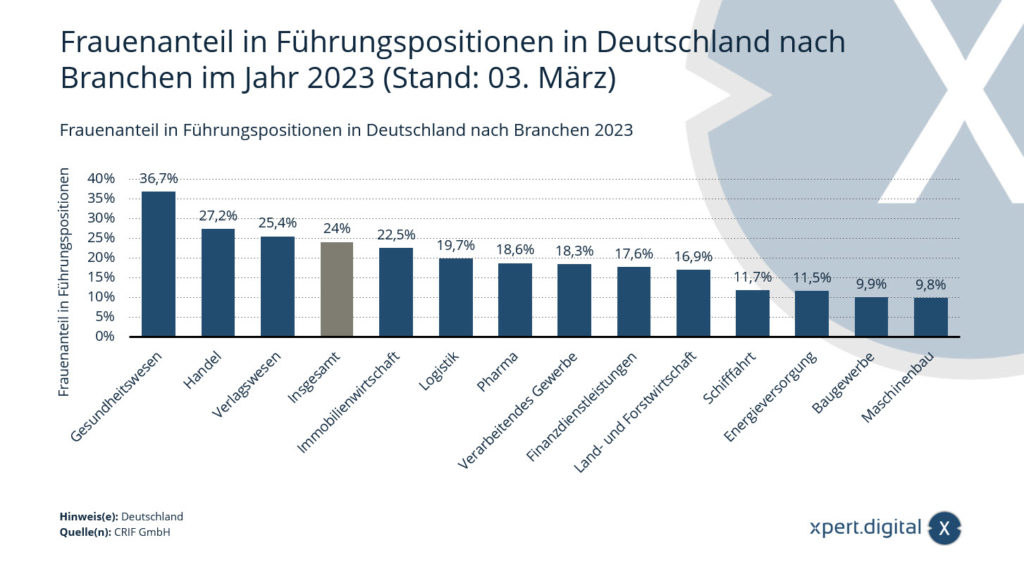
Proportion of women in management positions in Germany by industry in 2023 (as of March 3rd) – Image: Xpert.Digital
👩💼 Proportion of women in management positions in Germany by industry in 2023 (as of March 3rd) 📊
- 🩺 Healthcare – 36.70%
- 🛍️ Trade – 27.20%
- 📚 Publishing – 25.40%
- 🔗 Overall – 24%
- 🏠 Real Estate Industry – 22.50%
- 🚚 Logistics – 19.70%
- 💊 Pharmaceuticals – 18.60%
- 🏭 Manufacturing – 18.30%
- 💰 Financial Services – 17.60%
- 🌾 Agriculture and forestry – 16.90%
- 🚢 Shipping – 11.70%
- 💡 Energy supply – 11.50%
- 🏗️ Construction – 9.90%
- 🔧 Mechanical engineering – 9.80%
The latest statistics about the proportion of women in leadership positions in Germany show an interesting trend. Let's look at this data in more detail:
1. Healthcare 🏥
In the healthcare sector, the proportion of women in management positions is around 36.7 percent. This shows that the healthcare system in Germany is progressive and offers women opportunities to work at higher levels. It can also be seen as an indication of the importance of women's contribution in this sector.
2. Mechanical engineering 🔧
In contrast, the proportion of women in mechanical engineering is only 9.8 percent. This could be due to traditional gender roles and the dominance of men in technical jobs. Nevertheless, there are efforts to increase this proportion through initiatives and programs to promote women.
3. Overall consideration 🌍
Across Germany, the proportion of women in management positions is 24.0 percent. This shows that although there is progress, there is still a lot of room for improvement. It is important that more industries recognize the importance of including women in leadership roles.
4. Details about the data 📊
The data is based on around 2.5 million management positions in 1.2 million companies. These are positions such as managing directors, supervisory board members and chairmen, managing partners and board members and chairmen. These details underscore the breadth and depth of the study and its relevance to understanding the current state of affairs.
📝 Expert opinions on women in leadership positions
1. Growing trend 📈
Experts believe the growing number of women in leadership positions in some industries is due to a combination of educational initiatives, company policies and cultural change.
2. Importance of diversity 🌈
Diversity in leadership positions is often associated with better organizational performance. Companies that promote diversity benefit from different perspectives that can lead to innovative solutions.
3. Barriers and solutions 💪
There are still many barriers preventing women from reaching leadership positions. These include prejudices, lack of flexibility and lack of mentoring programs. Experts emphasize the need to recognize and actively combat these barriers.
📣 Similar topics
- 🏥 Women's power in healthcare: A growing trend
- 🔧 Mechanical engineering: How can we increase the proportion of women?
- 🌍 Women in leadership: A Germany-wide look
- 📊 Data in detail: What the numbers really tell us
- 📈 Expert Opinions: The Rise of Women in Leadership
- 🌈 Diversity in companies: Why it matters
- 💪 Overcoming barriers: The way to the top for women
- 🚀 Women in leadership: The key to corporate success
- ✊ More women on boards: Why now is the time
- 🎓 Education and training: The key to increasing the proportion of women
#️⃣ Hashtags: #WomenInLeadership #Equality #DiversityInBusiness #Leaders2023 #FutureOfWork
👩👨 Proportion of women and men in different professional groups in Germany 📈
🗒️ Development of employment of women and men and the gender pay gap
1️⃣ Historical development of gender in the labor market
It is undeniable that gender roles in the labor market have undergone significant changes over the years. While some occupations have historically been dominated by a particular gender, a review shows that female employment has steadily increased.
2️⃣ Women in education, home economics and theology
Women have traditionally been well represented in certain industries. The proportion of women was particularly high in 2022, particularly in the areas of education, home economics and theology. This could have historical, cultural or even social reasons.
3️⃣ Men dominate the construction industry
Skilled trades, particularly in construction, are still largely dominated by men. However, there are efforts to make this industry more accessible to women and thus promote gender balance.
4️⃣ Compatibility of family and work
Women still take on the lion's share of care work in families. This presents them with challenges when it comes to balancing family and work. In contrast, the employment rate of men with underage children in the household is significantly higher than that of women. There is an urgent need to create structures and policies that help both genders to balance work and family life effectively.
5️⃣ Earnings difference between men and women
Although the employment rate of women and men is becoming equal, there is still a significant difference in earnings between the genders. The so-called gender pay gap is a clear indication of structural inequalities in the workplace. This imbalance must be actively addressed to ensure a fair and equitable working world.
6️⃣ Comparison of the federal states in the gender pay gap
Interestingly, data shows differences in the gender pay gap between different federal states. This could be due to regional economic differences, cultural norms or education levels.
👩🌾 Proportion of women in various professional groups in Germany
On June 30, 2022 (subject to social security contributions and part-time employees)
- 📊 Overall – 46.40%
- 🍎 Education, social, housekeeper. Professions, theology – 83.90%
- 🩺 Medical Health Professions – 81.40%
- 💅 Non-med. Health, personal care/wellness professions, medical technology – 78.80%
- ⚖️ Professions in law and administration – 75.10%
- 🧹 Cleaning jobs – 74.10%
- 🛍️ Sales jobs – 70.70%
- 📖 Linguistics/Literature/Humanities/Social Sciences/Economics – 65.90%
- 🏨 Tourism, hotel and catering professions – 63.60%
- 🏢 Careers in business management and organization (office) – 63%
- 💵 Careers in financial services, accounting and tax consulting – 61.20%
- 🎓 Teaching and training professions – 55.40%
- 📈 Advertising, marketing, commercial and editorial media professions – 55.10%
- 🧣 Textile and leather professions – 54%
- 🎨 Product design, crafts – 51.10%
- 🍞 Food manufacturing and processing – 41.40%
- ❓ No assignment possible – 40.60%
- 🛒 Purchasing, sales and trading professions – 38.60%
- 🖨️ Paper, printing jobs, tech. Media design – 38%
- 🔬 Mathematics, biology, chemistry, physics professions – 37.70%
- 🎭 Performing, entertainment professions – 36%
- 🌍 Geology, geography, environmental protection professions – 31.70%
- 🏡 Construction planning, architecture, surveying professions – 30.30%
- 🌾 Agriculture, animal, forestry professions – 29.60%
- 🌺 Horticultural professions, floristry – 28.60%
- 📦 Traffic, logistics (except vehicle driving) – 27.40%
- 🚓 Protection, security, surveillance professions – 26.60%
- 🔧 Technical research, development, design and production control professions – 21.30%
- 💻 IT and other ICT professions – 17.70%
- 🪵 Plastic and wood production and processing – 15.30%
- ⛏️ Raw material extraction, glass and ceramic processing – 12.20%
- 🔌 Mechatronics, energy and electrical professions – 11%
- 🚗 Mechanical and automotive engineering professions – 10.20%
- 🏭 Metal production, processing, metal construction – 9.20%
- 🚌 Drivers of vehicle and transport equipment – 6%
- 🚿 Building and utility occupations – 4.50%
- 🛠️ (Interior) construction professions – 3.70%
- 🏗️ Civil engineering professions – 1.80%
📣 Similar topics
- 📊 Gender distribution in different professional fields: A deeper look
- 🏗️ Why men dominate the construction industry
- 🍼 Compatibility of family and work: A gender perspective
- 💰 The ongoing fight against the gender pay gap
- 🌍 Regional differences in the gender pay gap: What the federal states show
- 👩🏫 Women in Education and Theology: A Historical Perspective
- 🏠 Women in housekeeping: tradition meets modernity
- 💼 The evolution of women's employment over the years
- 👨👩👧👦 Care work and its effects on gender relations in the labor market
- 🎓 Education and its role in reducing the gender pay gap
#️⃣ Hashtags: #GenderEqualityInCareer #GenderPayGapChallenge #WomenInWork #MaleDominatedConstruction #FamilyAndCareerAgree
👩💼👩💼👩💼 Proportion of women in management positions in Germany by federal state 👩💼🗺️
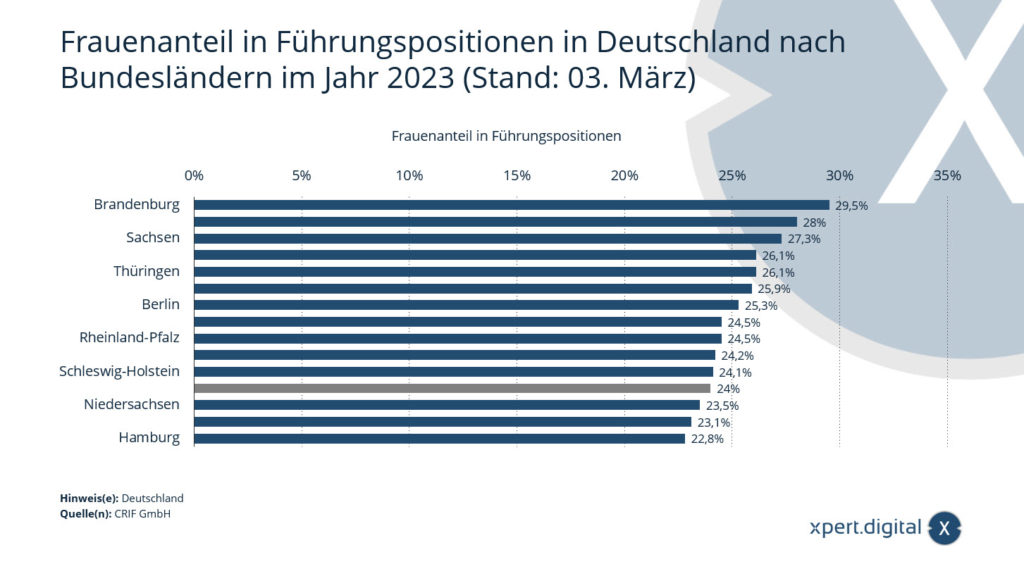
Proportion of women in management positions in Germany by federal state in 2023 (as of March 3rd) – Image: Xpert.Digital
🗒️👩💼👩💼 Proportion of women in management positions in Germany by federal state in 2023 (as of March 3rd)
- Brandenburg 🟢 29.50%
- Mecklenburg-Western Pomerania 🔵 28%
- Saxony 🔴 27.30%
- Saxony-Anhalt 🔶 26.10%
- Thuringia 🟣 26.10%
- Saarland 🟤 25.90%
- Berlin ⚫ 25.30%
- Hesse ⚪ 24.50%
- Rhineland-Palatinate 🟡 24.50%
- Bavaria 🔵⚪ 24.20%
- Schleswig-Holstein 🟦 24.10%
- Germany 🇩🇪 24%
- Lower Saxony 🟢⚪ 23.50%
- North Rhine-Westphalia 🔴⚪ 23.10%
- Hamburg ⚓ 22.80%
- Baden-Württemberg ⚫⚪ 22.20%
- Bremen 🟣⚪ 19.50%
The statistics section described offers us an interesting insight into the proportion of women in leadership positions in Germany, particularly in relation to the state of Brandenburg and the national average. Let's take a closer look at this information and discuss its meaning in a larger context.
📈 Women in leadership positions: A look at the numbers
Women in leadership positions have been a topic of great interest for years, both in Germany and worldwide. The statistics from March 2023 show that Brandenburg, with a proportion of women of 29.5% in management positions, is above the national average of 24%.
👩💼 The different leadership roles in detail
According to the information provided, the management positions are managing directors, supervisory board members and chairmen, managing partners and board members and chairmen. It is interesting to observe how the proportion of women in these different positions has developed and what role it plays in the different industries and federal states.
📊 Comparison with other federal states
Without the exact figures from other federal states, it is not clear where Brandenburg stands in comparison. But the above-average proportion of women in Brandenburg could indicate that there are initiatives or programs there that contribute to increasing the proportion of women.
💡 Challenges and opportunities
Despite progress, there are still numerous challenges women in leadership positions face, including discrimination, unequal pay and work-life balance issues. At the same time, increasing the inclusion of women in leadership positions also presents many opportunities, including more diverse perspectives, improved decision-making and a more positive work environment.
🌐 Global context
There are also efforts at the global level to increase the proportion of women in leadership positions. It would be interesting to see how Germany compares to other countries and what best practices could be adopted from the international arena.
📣 Similar topics
- 📈 Women in leadership positions: A detailed overview
- 👩💼 Leadership roles: Where are women today?
- 📊 Brandenburg exceeds the national average: A deeper look
- 💡 The biggest challenges and opportunities for women in leadership
- 🌐 Women in leadership positions: A global comparison
- 📉 How Brandenburg exceeds the national average
- 🌟 The importance of diversity in business management
- 💪 Promoting women in leadership positions: Why it matters
- 🌍 Germany in international comparison: women in leadership
- 🚀 The way forward: More women in top positions
#️⃣ Hashtags: #WomenInLeader #BrandenburgFührt #Equal Rights #GlobalPerspective #ChancesAndChallenges
🗒️ Proportion of women in leadership positions in Germany 2023
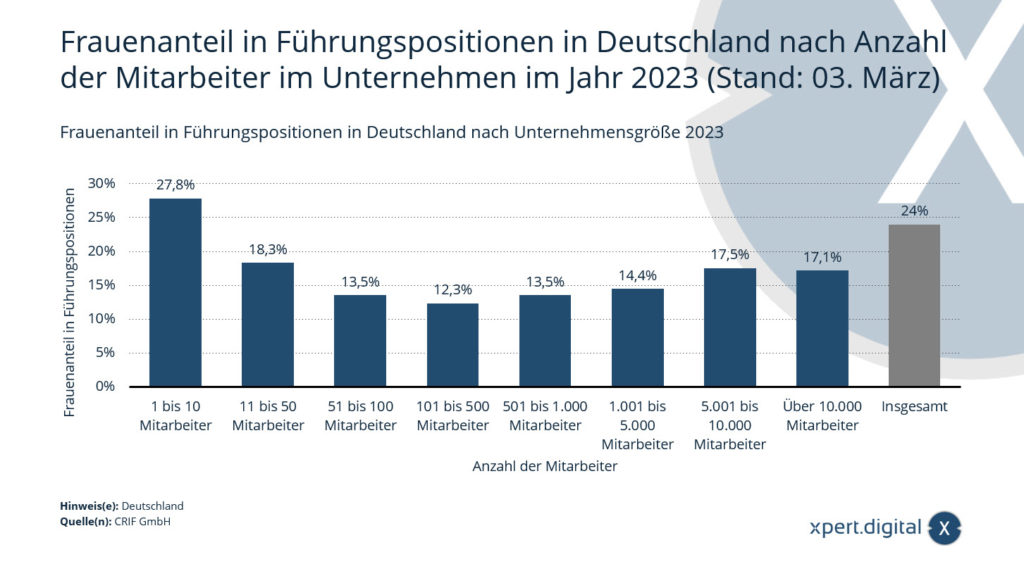
Proportion of women in management positions in Germany according to the number of employees in the company in 2023 (as of March 3rd) - Image: Xpert.Digital
👩💼👩💼 Proportion of women in management positions in Germany according to the number of employees in the company in 2023 (as of March 3rd)
- 1 to 10 employees – 27.80%
- 11 to 50 employees – 18.30%
- 51 to 100 employees – 13.50%
- 101 to 500 employees – 12.30%
- 501 to 1,000 employees – 13.50%
- 1,001 to 5,000 employees – 14.40%
- 5,001 to 10,000 employees – 17.50%
- Over 10,000 employees – 17.10%
- Overall – 24%
The proportion of women in leadership positions has increased steadily in recent years in many countries, including Germany. The latest statistics for 2023 show that this trend is also continuing in Germany, although there is still a lot to do.
In companies with more than 10,000 employees, the proportion of women in management positions is 17.1 percent. Overall, the proportion of women in management positions throughout Germany is around 24.0 percent. This data is based on an evaluation of around 2.5 million management positions in 1.2 million companies. These leadership positions include roles such as managing directors, supervisory board members and chairmen, managing partners and board members and chairmen.
It's important to put these numbers in context and compare them to previous years. This is the only way to truly assess progress in terms of gender equality in leadership positions.
🎓 Expert opinions on gender distribution in leadership positions
🧐 The meaning of numbers
An increase in the proportion of women in leadership positions not only means equality in the workplace, but also reflects social development in which women and men receive equal recognition and opportunities in the world of work.
📊 Comparison with previous years
Although the current proportion of women in leadership positions is encouraging, a look back shows that there is still a long way to go towards full equality.
📈 Advantages of mixed leadership
Research has shown that diverse teams are more creative and innovative. Companies with a higher proportion of women in management positions can benefit from these advantages.
🌍 International comparison
It is also interesting to see how Germany compares internationally. Other countries can be role models or show where there is still room for improvement.
🔍 Challenges and solutions
Despite the positive trend, there are still challenges that women in leadership positions have to face. However, there are also many solutions that could help overcome these hurdles.
📣 Similar topics
- 📌 Women in leadership: Germany in 2023
- 👩💼 On the way to equality: The increasing proportion of women in leadership positions
- 🌟 Why mixed leadership teams are worth their weight in gold
- 🌐 Germany in international comparison: Where are we?
- 🚀 Women in Leadership: The Next Steps
- 💪 Overcoming challenges: women at the top
- 💡 Innovative power through diversity in leadership positions
- 🎯 Goals for the future: More women in leadership
- 🤝 Equality in companies: More than just numbers
- 🔝 Best Practices: Successful companies with women in leadership positions
#️⃣ Hashtags: #WomenInLeadership #GenderEquality #Germany2023 #InnovationThroughDiversity #EqualOpportunityAtWork
👩💼📊 Proportion of women in management positions in Germany according to sales 💶 of companies in 2023
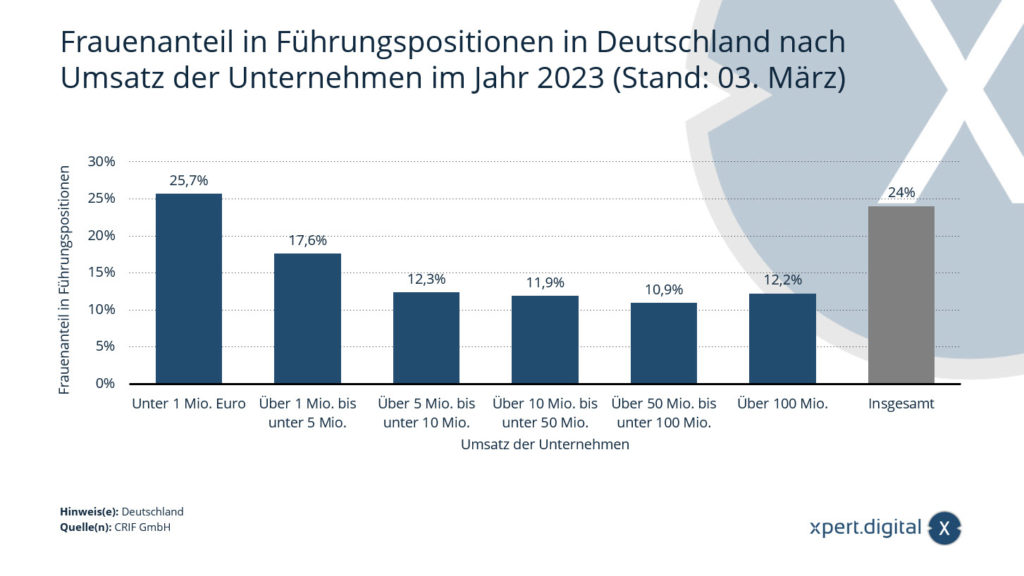
Proportion of women in management positions in Germany according to company turnover in 2023 (as of March 3rd) – Image: Xpert.Digital
💼👩💼📊 Proportion of women in management positions in Germany according to sales 💶 of companies in 2023 (as of March 3rd)
- Under 1 million euros – 25.70%
- Over 1 million to under 5 million – 17.60%
- Over 5 million to under 10 million – 12.30%
- Over 10 million to under 50 million – 11.90%
- Over 50 million to under 100 million – 10.90%
- Over 100 million – 12.20%
- Overall – 24%
Germany has always worked to ensure equality in the workplace. Nevertheless, the discrepancy between men and women in leadership positions remains a hotly debated topic. The latest statistics for 2023 show interesting insights into the proportion of women in leadership positions, especially with regard to company sales.
1️⃣ The base numbers
In companies that achieved sales of between 1 and 5 million euros, the proportion of women in management positions was 17.6 percent. Across Germany the proportion was 24.0 percent. These numbers come from a comprehensive analysis of 2.5 million leadership positions in 1.2 million companies.
2️⃣ What exactly does “leadership position” mean?
It is important to clarify what is understood as “management positions”. This includes managing directors, members of the supervisory board and chairman, managing partners as well as board members and chairwoman.
👩💼 Why is this percentage important?
The proportion of women in leadership positions is an indicator of progress towards gender equality. A higher proportion of women in such positions can lead to more diverse decision-making processes and better business results.
3️⃣ Comparison with previous years
Unfortunately, previous years' data is missing from the search results provided, but it would be interesting to know how these numbers have changed over time. Have they gained or lost weight? This gives us insight into the progress (or lack thereof) towards equality.
🌐 A global comparison
How does Germany compare to other countries? A global comparison could provide insight into where Germany stands in terms of gender equality in leadership positions.
4️⃣ The impact on the economy
There are many studies that show that companies with diverse leadership are more successful. With a higher proportion of women in leadership positions, companies could make better decisions and become more innovative.
📊 The numbers behind the percentages
It would also be interesting to know how these percentages translate to absolute numbers. How many women are in leadership positions in companies of different sales sizes?
5️⃣ Steps towards equality
It is clear that there is still room for improvement. There are many initiatives and programs aimed at increasing the proportion of women in leadership positions.
🤝 Working together to achieve equality
Businesses, governments and NGOs must work together to create real change. With joint efforts, we can create an equal future.
📣 Similar topics
- Women at the top: How Germany will perform in 2023 📊
- Leadership positions: Who are the decision-makers in German companies? 👩💼
- Gender equality: A look at the numbers 📉
- The economy and women in leadership positions: A win-win situation 🌟
- The global comparison: Where does Germany stand? 🌍
- Progress Over Time: A Historical Review ⏳
- The importance of gender diversity in companies 🌈
- Women in Business: An Unstoppable Rise? 🚀
- Equality: Why it matters and how we can achieve it 🤝
- The future of female leadership in Germany: What awaits us 🌐
#️⃣ Hashtags: #GenderEquality #LeadershipWomen #GermanEconomy #WomenInLeadership #ZukunftDerGleichrechte
🗒️ Xpert.Digital: A pioneer in the field of extended and augmented reality

Find the right Metaverse agency and planning office such as a consulting firm - Image: Xpert.Digital
🗒️ Find the right Metaverse agency and planning office such as a consulting firm - search and search for top ten tips for consulting & planning
In the age of digitalization, where technologies such as Extended Reality (XR) and the Metaverse are constantly becoming more relevant, Xpert.Digital positions itself as an opinion leader and pioneer. With over 1,500 specialist articles, Xpert.Digital has established itself as a central point of contact for the industry.
🌌 Extended Reality (XR): The best of both worlds
Extended Reality is a collective term that includes virtual reality (VR), mixed reality (MR) and augmented reality (AR). Xpert.Digital is committed to creating immersive XR experiences that are both informative and entertaining.
- Interactive Experiences: XR allows users to immerse themselves in virtual worlds and interact with their surroundings in ways previously unimaginable.
- Education and Training: XR can be used for educational purposes to convey complex topics and concepts in an understandable and tangible way.
- Entertainment: Whether games, films or art – XR opens new horizons in digital entertainment.
🔮 Augmented Reality (AR): See the world through digital eyes
Augmented Reality, a particular focus of Xpert.Digital, makes it possible to integrate digital information or graphics into the real world. The possibilities are nearly unlimited.
- Marketing and Advertising: AR can be used to create interactive advertising campaigns that engage customers in a whole new way.
- Everyday help: From navigation apps that project the route directly onto the street to furniture apps that show what a new sofa would look like in the living room - AR makes it possible.
🌐 The Metaverse: The Next Big Thing
The Metaverse is a virtual world where people can interact through avatars and create shared experiences. Xpert.Digital recognizes the enormous potential of the Metaverse and is working to translate this potential into usable products and services.
- Social Interaction: The Metaverse offers the opportunity to connect with people from all over the world and share common experiences.
- Economy and trade: Virtual goods and services can be traded in the metaverse, which opens up completely new business models and sources of income.
- Creative Freedom: From building your own worlds to designing custom avatars, the Metaverse is a place of endless creative possibilities.
🚀 Xpert.Digital at the forefront of innovation
Xpert.Digital shows how a company can be at the forefront of the technological revolution. With their focus on XR, AR and the Metaverse, they are well positioned to shape and define the future of digital interaction.
More about it here:
🗒️ If you don't understand something or need advice, we also offer training and workshops

Metaverse & Extended Reality training, lecture or workshop for augmented, mixed and virtual reality – Xpert.Digital
In today's digital era, technology is evolving at a rapid pace. There are constantly new terms and technologies that need to be understood and mastered. If you're having trouble keeping up with topics like Metaverse, XR technologies, or immersive 3D, you're not alone.
More about it here:
What options are there to convince colleagues and superiors within the company of the fascinating possibilities with a B2B metaverse?
To convince your colleagues and superiors of the fascinating possibilities of a B2B metaverse, you can use the following approaches:
Familiarize yourself with the benefits
Learn more about the benefits of a B2B metaverse and how it can increase efficiency, improve product presentation, and open up new business opportunities. Prepare a list of key benefits you can use during presentations or discussions.
Demonstration of use cases
Collect examples and case studies that show how companies are already successfully using a B2B metaverse. Present these examples to illustrate the practical applications and potential positive impact on business operations.
Present concrete data and statistics
Collect data and statistics that demonstrate how using a B2B metaverse can positively impact business performance. This could, for example, be information about increased sales figures, improved customer satisfaction or increased efficiency.
Organize internal presentations or workshops
Plan presentations or workshops to demonstrate the functionality and possibilities of a B2B metaverse to your colleagues and superiors. Show them live what a product presentation or interactive training can look like in a virtual environment.
Create an immersive experience
Use technology to provide an immersive experience for your colleagues and managers. For example, invite them to a virtual showroom tour or a virtual product presentation. This allows them to experience the potential and fascinating possibilities of a B2B metaverse first hand.
Emphasize competitiveness
Make it clear that using a B2B metaverse can give your company a competitive advantage. Show how other companies in your industry are already successfully using this technology and how your company could benefit from not falling behind the competition.
Offer training and support
Make sure your colleagues and managers receive the necessary training and support to understand and use the technology. For example, offer training or materials that make it easier for you to get started.
Present cost-benefit analyses
Conduct cost-benefit analyzes to show that using a B2B Metaverse makes long-term economic sense. Emphasize how the investment in technology can pay off in improved efficiency, increased productivity, or increased sales.
➡️ Through a convincing presentation, showing concrete benefits and use cases, and providing training.
➡️ If you need support here, please contact us. We are happy to help. One of the strengths of Xpert.Digital is its pioneering business development.
Another solution would be the following intermediate step
Instead of having high-quality pictures for your products in catalogs, brochures and brochures by external media service providers at a high price, you can implement this with an 'XR-3D rendering machine'. By implementing such a technology, you get very close to the implementation of your own industry & business meta -verse solution.
- Lathe in photorealistic representation (3D product presentation)
- Lathe in photorealistic representation (3D product presentation)
More about it here:
By investing in an 'XR-3D rendering machine', you enable yourself to create high-quality images of your products in an efficient and inexpensive process. This machine uses the power of the 3D rendering to generate photo-realistic representations of your products. You can create different views and perspectives and even integrate interactive elements to offer an immersive experience.
By using an 'XR-3D rendering machine', reduce your dependence on external media service providers and at the same time reduce your costs. You have control over the entire process and can react quickly to changes and adjustments. They are also able to generate a large number of product images without causing additional costs.
This intermediate step brings you closer to your own Industry & Business Metaverse solution. With XR technology you can break the boundaries of traditional media and offer your customers an innovative and interactive experience. You can present your products in virtual environments, enable individual configurations and give customers unique insights into your products and services.
By making the move to an XR 3D rendering machine, you are laying the foundation for future developments towards your own Industry & Business Metaverse solution. You will be able to optimize your business processes, strengthen your customer loyalty and stand out from your competitors. It is a step towards innovation and competitiveness in the digital world.
We are there for you - advice - planning - implementation - project management
Xpert.Digital - Pioneer Business Development
Smart Glasses & KI - XR/AR/VR/MR industry expert
Consumer metaverse or meta -verse in general
If you have any questions, further information and advice, please feel free to contact me at any time.
I would be happy to serve as your personal advisor.
You can contact me by filling out the contact form below or simply call me on +49 89 89 674 804 (Munich) .
I'm looking forward to our joint project.
Xpert.Digital - Konrad Wolfenstein
Xpert.Digital is a hub for industry with a focus on digitalization, mechanical engineering, logistics/intralogistics and photovoltaics.
With our 360° business development solution, we support well-known companies from new business to after sales.
Market intelligence, smarketing, marketing automation, content development, PR, mail campaigns, personalized social media and lead nurturing are part of our digital tools.
You can find out more at: www.xpert.digital - www.xpert.solar - www.xpert.plus



